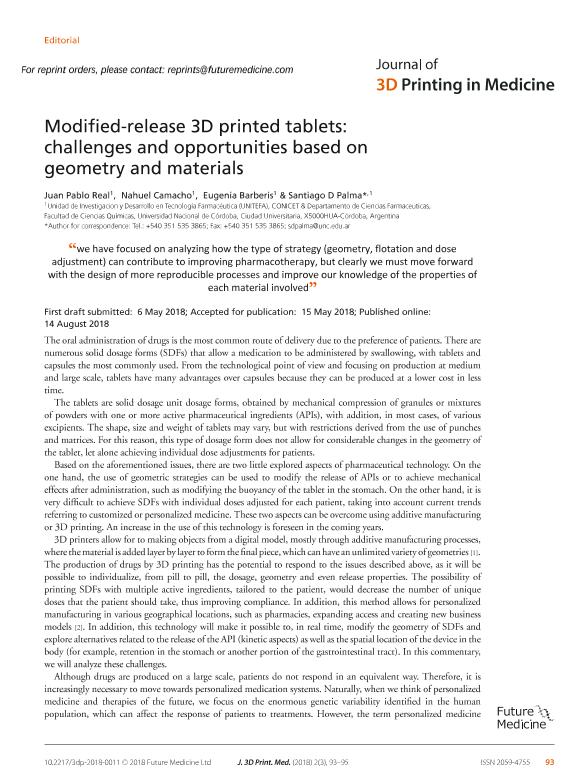Artículo
Modified-release 3D printed tablets: challenges and opportunities based on geometry and materials
Fecha de publicación:
14/06/2018
Editorial:
Future Medicine
Revista:
Journal of 3D Printing in Medicine
ISSN:
2059-4763
e-ISSN:
2059-4755
Idioma:
Inglés
Tipo de recurso:
Artículo publicado
Clasificación temática:
Resumen
The oral administration of drugs is the most common route of delivery due to the preference of patients. There arenumerous solid dosage forms (SDFs) that allow a medication to be administered by swallowing, with tablets andcapsules the most commonly used. From the technological point of view and focusing on production at mediumand large scale, tablets have many advantages over capsules because they can be produced at a lower cost in lesstime.Based on the aforementioned issues, there are two little explored aspects of pharmaceutical technology. On theone hand, the use of geometric strategies can be used to modify the release of APIs or to achieve mechanicaleffects after administration, such as modifying the buoyancy of the tablet in the stomach. On the other hand, it isvery difficult to achieve SDFs with individual doses adjusted for each patient, taking into account current trendsreferring to customized or personalized medicine. These two aspects can be overcome using additive manufacturingor 3D printing. An increase in the use of this technology is foreseen in the coming years.
Palabras clave:
3D PRINTING
,
FLOATING
Archivos asociados
Licencia
Identificadores
Colecciones
Articulos(UNITEFA)
Articulos de UNIDAD DE INVESTIGACION Y DESARROLLO EN TECNOLOGIA FARMACEUTICA
Articulos de UNIDAD DE INVESTIGACION Y DESARROLLO EN TECNOLOGIA FARMACEUTICA
Citación
Real, Juan Pablo; Camacho, Nahuel Matias; Barberis, Maria Eugenia; Palma, Santiago Daniel; Modified-release 3D printed tablets: challenges and opportunities based on geometry and materials; Future Medicine; Journal of 3D Printing in Medicine; 2; 3; 14-6-2018; 93-95
Compartir
Altmétricas




